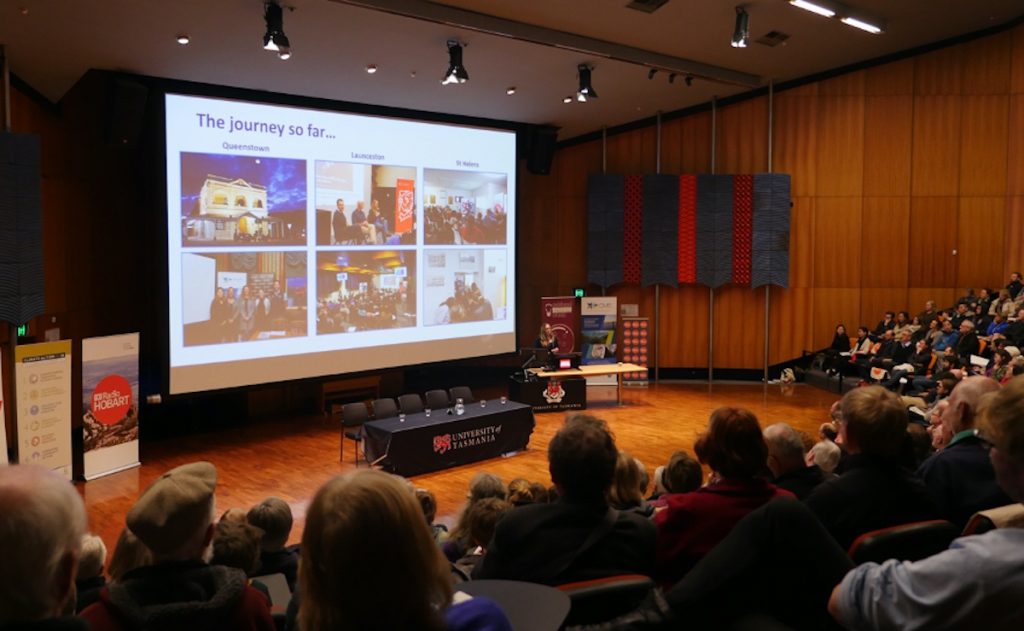
Picture: Clara presents at Curious Climate in response to a question about bioengineering, explaining other ways scientists are trying to engineer biological phenomena that can help keep more carbon contained in the earth and our oceans. Credit: ABC Northern Tasmania.
By Clara Rodriguez Vives
So often climate change communication takes a top-down approach, with experts telling the general public what they think people need to know. That was until the Curious Climate experiment came along with an approach that completely turns that top-down model on its head – and, fortunately, I was invited to take part in it.
The Curious Climate approach to engaged science communication starts by asking the public what they want to know about climate change, before planning a series of public presentations that then address the main questions of interest in each particular geographic region. It’s an innovative approach that has allowed local journalists and their media outlets to provide audiences with trustworthy, relevant information about climate change.
This engaged journalism experiment is being led by the Centre for Marine Socioecology in collaboration with public broadcaster the ABC. Other partners include the Institute for Marine and Antarctic Studies (IMAS), CSIRO, the Tasmanian Institute of Agriculture and various groups at the University of Tasmania.
Curious Climate was led by Dr Joce Nettfold, who asked Tasmanians what climate questions they wanted to be answered. Then scientists from partnered institutions, led by Professor Gretta Pecl, created locally relevant content in various forms according to those questions. Afterwards, the science teams travelled to each region in Tasmania to address the locally requested questions giving a series of short public presentations followed by Q&A sessions.
The first town to be visited by the Curious Climate crew was Queenstown in Western Tasmania where I was included as part of the science team that included Prof Gretta Pecl (Director of the Centre for Marine Socioecology), Dr Ingrid van Putten (CSIRO Oceans and Atmosphere) and Dr Stuart Corney (ACE CRC at IMAS). Each of us brought prepared content to create short presentations to address the questions as part of a public event that was recorded by the ABC.
The journey to Queenstown was fascinating. We travelled across the state from Hobart to the West Coast and drove through the most astonishing national parks. I was amazed by drastic changes in the landscape between regions and then, as dusk fell, became disconcerted when we came upon hills stripped of timber as we approached Queenstown. The bare hills were the result of it being an old mining town that has produced copper, silver and gold for more than 120 years. Colonial architecture gives Queenstown a powerful sense of the past, including the heritage-listed Empire Hotel, which was where we held this first event.
Locals and people from different parts of the world found themselves in Queenstown that night gathered in the room and listened to us, engaging us with even more questions and, dare I say it, becoming more curious about local climate change issues. It was a very successful evening where I got to experience climate change communication first-hand, with a remarkable team of scientists that I look up to, not only professionally, but also personally. Importantly, Curious Climate was the perfect opportunity to understand how the public perceives science and how a bridge between the two is essential to fulfil the purpose of our work as scientists.

This very regional approach helps us overcome the challenges of communicating our science. The magnitude and impact of global warming and its immediate effects on the environment are hard to comprehend, at global, regional and local scales. Along with scientific complexity, political and cultural conflict, and psychological factors all affect the way people perceive climate change coverage. As a consequence, there is a big breach between the awareness of climate change and an adequate response to it from the public. People struggle to understand, or in some cases simply don’t want to understand, the imminent impact of climate change and global warming.
That’s why finding new ways to communicate matters. Transforming our approach to locally focussed reporting on climate presents opportunities to expand the awareness of climate change challenges, present more positive journalism and raise the understanding of local news audiences. The Curious Science approach achieves this and responds to the interests of communities rather than telling them what we think they need to know.
For me, it was an incredibly valuable event and I look forward to seeing it continue to grow and visit regional areas all around our State and perhaps and beyond.
For more information, or to see full videos from the Curious Climate project, please visit: https://curiousclimate.org.au
